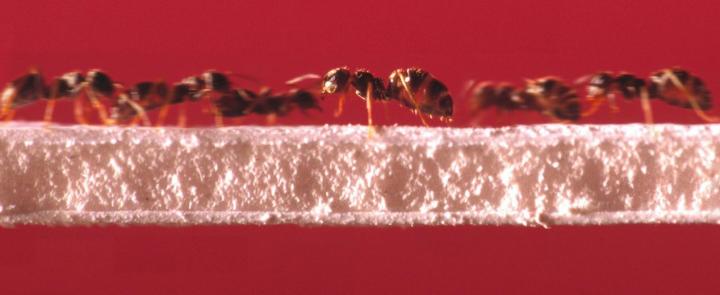
Credit: Emmanuel PERRIN/CRCA/CNRS Photothèque
Whether they occur on holiday routes or the daily commute, traffic jams affect cars as well as pedestrians. Scientists at the Research Center on Animal Cognition (CNRS/Université Toulouse III – Paul Sabatier) and the University of Arizona (United States) have demonstrated that ant colonies, however, are spared these problems and circulate easily, even in the event of extremely dense traffic, thus ensuring consistent efficiency in their foraging. These findings appear in the 22 October 2019 edition of eLife.
Traffic jams are a perfect example of what happens when too many individuals circulate together in the same space. Movements in large ant colonies, however, seem to sidestep this problem. To solve the mystery of how ants manage traffic so wonderfully, researchers conducted 170 filmed experiments to observe ants commuting between their nest and a food source. Tests took into account the width of the path and the number of individuals included in the study (between 400 and 25,600) in order to vary the density – the number of insects per unit of surface.
What they saw surprised them: when density increases, ant flows (1) swell and then become constant, whereas human traffic, above a certain density threshold, slows to zero flow and causes a jam (2). Ants, on the other hand, accelerate until a maximum flow or capacity on the path is reached. When traffic becomes too dense and causes too many collisions between ants, they change tactics, preferring to avoid time-consuming collisions instead of continuing to accelerate. Similarly, researchers noted that at excessively high density levels, ants refrain from joining the flow of traffic and wait for it to thin out instead.
While ant traffic is comparable to pedestrian and vehicle flows in many ways, it is also fundamentally different. Ants, protected by their exoskeleton, are not afraid of collisions and can accelerate where we humans prefer to slow down. In addition, movements in ant colonies share a common goal: foraging, which is carried out effectively regardless of density. Ants seem to avoid the traffic jam trap by continuously adapting their traffic rules to suit local crowding, whereas car traffic follows invariable rules such as stopping at a red light regardless of traffic.
###
Notes
(1) Number of individuals covering a given distance per unit of time.
(2) Variation in flow according to density is illustrated by a bell curve.
Media Contact
Veronique Etienne
[email protected]
33-144-965-137
Original Source
https:/
Related Journal Article
http://dx.




